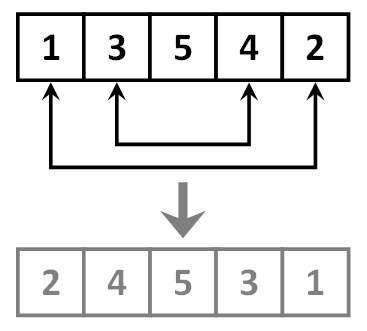Reversing an Array
by Zoran Horvat
Problem Statement
Given an array containing integer numbers, write a function which reverses the array. The first element of the array becomes the last; the second element becomes one before last, etc.
Example: Suppose that array consists of numbers 1, 3, 5, 4, 2. Function should reverse the array so that it becomes 2, 4, 5, 3, 1.
Problem Analysis
In this exercise we need to change places of array elements. For example, first element should come to the last position in the array. However, note that last element of the array should also become the first element. Similarly, while second element should come to one before last place, the element at that place should come to the second position in the array. Conclusion is that pairs of elements should actually exchange their places, which greatly simplifies the task. Picture below shows the exchange scheme in an array with five elements:

Note how the element in the middle of the array remains in place. This effect is observable only in arrays with odd length. Note also that there are only two exchange operations for the array with five elements. In six-element array, there would need to be three exchange operations. In general, reversing an array with N elements requires FLOOR(N/2) pair-wise exchange operations. Here is the function which reverses elements of an array:
function Reverse(a, n)
a - array with one-based indices
n - length of the array
begin
k = FLOOR(n / 2) -- integer division
for i = 1 to k
begin
x = a[i]
a[i] = a[n - i + 1]
a[n - i + 1] = x
end
end
Implementation
Below is the complete implementation of console application in C# which generates and reverses arrays of integer numbers. Note that this implementation calculates element indices differently because arrays in C# are zero-based.
using System;
namespace ReversingArrays
{
public class Program
{
static int[] CreateArray(int n)
{
int[] a = new int[n];
for (int i = 0; i < n; i++)
a[i] = i + 1;
return a;
}
static void PrintArray(int[] a)
{
for (int i = 0; i < a.Length; i++)
Console.Write("{0,3}", a[i]);
Console.WriteLine();
}
static void Reverse(int[] a)
{
for (int i = 0; i < a.Length 2; i++)
{
int x = a[i];
a[i] = a[a.Length - i - 1];
a[a.Length - i - 1] = x;
}
}
static void Main(string[] args)
{
while (true)
{
Console.Write("Enter length of the array (zero to exit): ");
int n = int.Parse(Console.ReadLine());
if (n <= 0)
break;
int[] array = CreateArray(n);
PrintArray(array);
Reverse(array);
PrintArray(array);
}
}
}
}
Demonstration
When application is run, it produces output like this:
Enter length of the array (zero to exit): 5
1 2 3 4 5
5 4 3 2 1
Enter length of the array (zero to exit): 6
1 2 3 4 5 6
6 5 4 3 2 1
Enter length of the array (zero to exit): 0
If you wish to learn more, please watch my latest video courses

Beginning Object-oriented Programming with C#
In this course, you will learn the basic principles of object-oriented programming, and then learn how to apply those principles to construct an operational and correct code using the C# programming language and .NET.
As the course progresses, you will learn such programming concepts as objects, method resolution, polymorphism, object composition, class inheritance, object substitution, etc., but also the basic principles of object-oriented design and even project management, such as abstraction, dependency injection, open-closed principle, tell don't ask principle, the principles of agile software development and many more.
More...

Design Patterns in C# Made Simple
In this course, you will learn how design patterns can be applied to make code better: flexible, short, readable.
You will learn how to decide when and which pattern to apply by formally analyzing the need to flex around specific axis.
More...

Refactoring to Design Patterns
This course begins with examination of a realistic application, which is poorly factored and doesn't incorporate design patterns. It is nearly impossible to maintain and develop this application further, due to its poor structure and design.
As demonstration after demonstration will unfold, we will refactor this entire application, fitting many design patterns into place almost without effort. By the end of the course, you will know how code refactoring and design patterns can operate together, and help each other create great design.
More...

Mastering Iterative Object-oriented Development in C#
In four and a half hours of this course, you will learn how to control design of classes, design of complex algorithms, and how to recognize and implement data structures.
After completing this course, you will know how to develop a large and complex domain model, which you will be able to maintain and extend further. And, not to forget, the model you develop in this way will be correct and free of bugs.
More...
About

Zoran Horvat is the Principal Consultant at Coding Helmet, speaker and author of 100+ articles, and independent trainer on .NET technology stack. He can often be found speaking at conferences and user groups, promoting object-oriented and functional development style and clean coding practices and techniques that improve longevity of complex business applications.
Elsewhere
Video Courses
- Making Your C# Code More Object-oriented
- Beginning Object-oriented Programming with C#
- Collections and Generics in C#
- Design Patterns in C# Made Simple
- Refactoring to Design Patterns
- Mastering Iterative Object-oriented Programming in C#
- Making Your C# Code More Functional
- Making Your Java Code More Object-oriented
- Writing Purely Functional Code in C#
- Tactical Design Patterns in .NET: Creating Objects
- Tactical Design Patterns in .NET: Control Flow
- Tactical Design Patterns in .NET: Managing Responsibilities
- Advanced Defensive Programming Techniques
- Writing Highly Maintainable Unit Tests
- Improving Testability Through Design
Articles
- Here is Why Calling a Virtual Function from the Constructor is a Bad Idea
- What Makes List<T> So Efficient in .NET?
- Nondestructive Mutation and Records in C#
- Understanding Covariance and Contravariance of Generic Types in C#
- Using Record Types in C#
- Unit Testing Case Study: Calculating Median
- More...